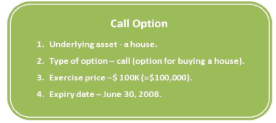A call option is a security giving its owner the right to purchase an asset, known as the “underlying asset”
(for example: a house), at a price agreed upon in advance, which is known as the “strike price” (for example: $100,000).
An option has a limited duration. The option contains a definition of the “underlying asset”, what the terms of purchase are and the duration of the option. We purchase the “underlying asset” from the “option writer”, who we talk about later. Buying an option is similar to buying a lottery ticket. You buy, in the expectation of making a profit. If you do not make a profit, the option becomes “garbage”.
Examples of an Underlying Asset
An underlying asset can be any asset, but the most common assets are standard assets, such as: An ounce of gold, 1,000 barrels of oil, 100 “Microsoft Corp.” shares etc. There are some intangible assets also, such as share indexes, which we will deal with in more detail later on.

Underlying Asset in the Example: House
In order to simplify understanding of the subject, we will use an example where the “underlying asset” is a house at an imaginary vacation resort, where all the houses are of the same size and price. The prices of the houses change daily according to the number of vacationers at the resort. The more vacationers there are in town, the greater the price is and likewise, the fewer vacationers in town, the lower the price will be.
Premium
The price we pay for the option is known as the premium. The premium is like the price we pay for a lottery ticket.
Exercising the Call option
We will exercise the Call option only if we are able to buy the underlying asset at a price lower than the market price. If this is not possible, we will throw the option in the garbage.
Call Options Explained – Characteristics
Every option (both Put and Call) are characterized by four items of data which are known in advance, as follows:
Illustration 1- Example of Call option data

- Underlying asset: In our example, the underlying asset is the house in the vacation resort.
- Type of option: Call.
- Exercise price: The price which the option holder pays for the house if he decides to exercise the option. In our example, he would pay $100K for the house. The exercise price is a fixed price, which is known in advance and is not affected by the market price.
- Expiry date: Every option has a limited duration. The expiry date stated is the last day of its life and after that date it becomes worthless. The duration of an option varies from market to market. Usually its duration is less than one year.
Period of Exercise of the Option
A distinction is made between two methods:
- The American method – the option can be realized at any time up to the expiry date.
- The European method – the option can be exercised only at the date of expiry.


